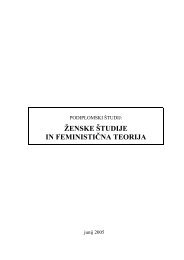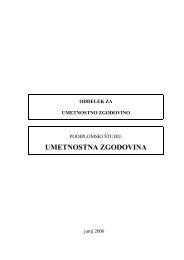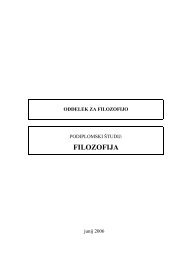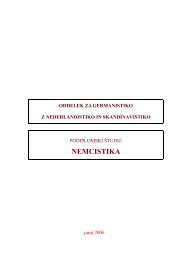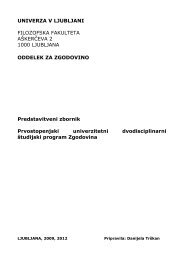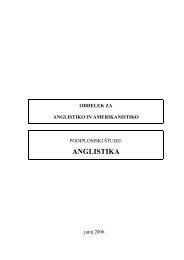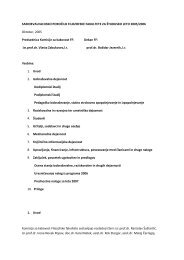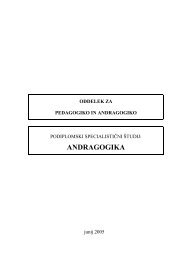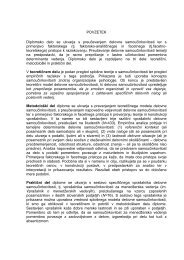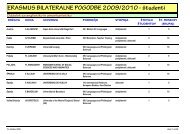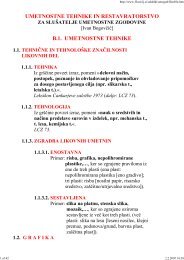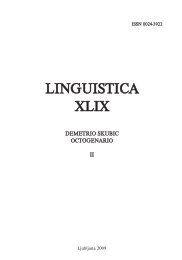B_solo_zgibanke male new_1 - Filozofska fakulteta
B_solo_zgibanke male new_1 - Filozofska fakulteta
B_solo_zgibanke male new_1 - Filozofska fakulteta
Create successful ePaper yourself
Turn your PDF publications into a flip-book with our unique Google optimized e-Paper software.
the ‘immediate vicinity of the predicate’ means the position immediately before the<br />
predicate or coinciding with the predicate up to just before the modality form<br />
(“immediately before P to before M” in the table), and coinciding with or after the<br />
modality form (“Coinciding with M or after M” in the table).<br />
in the case when an intervention can occur concurrently with or after the<br />
utterance final modality form, then interventions due to prediction and ex post facto<br />
judgment at the end of the bracket cannot be distinguished and were therefore left<br />
out of consideration. thus, only those cases when an intervention occurred in the<br />
position ranging from immediately before the predicate up to the beginning of the<br />
modality form were considered. these interventions should more likely be due to<br />
the hearer’s hypothetical prediction of the modality form type. if this were indeed<br />
the case, then the proportion of interventions in this position for the LOW group<br />
should be expected to be lower than the proportion of interventions at the same<br />
position in the HiGH group.<br />
this is illustrated below in (6), which is actually the last part of example (5). Here<br />
the relevant interventions are marked with an asterisk and precede the predicate in<br />
speaker y’s utterance.<br />
(6) [P:un yeah] , ni natte ikutte iu ka koo, or how should i say, thus...<br />
[P:un yeah] /ko, koyuu no, bunkatte iu ka, should i say the particular cultures<br />
* [P:aaa, dakara boodaresu ni, natteiku to<br />
yeah, therefore, by becoming border-less], ee, yeah<br />
* [P:kentiku no of architecture] usuretei[ku]yoona are getting dimmer and dimmer<br />
[P:unun yeah, yeah] /ki ga surun desukeredomo. it seems to be [like that]...<br />
P:naruhodo nee, uuni see, yeah...<br />
Oikawa (1998)<br />
the timing of the first intervention, a co-construction type, [P:aaa, dakara boodaresu<br />
ni, natteiku to yeah, therefore, by becoming border-less] may not only be due to the<br />
hearer’s prediction of the predicate alone, but perhaps also to y’s hesitation ee in<br />
this transcription immediately following the intervention, while possibly uttered at<br />
more or less the same time, may have also have been a clue. Hearer P’s second,<br />
shorter intervention, also of the co-construction type, [P:kentiku no of architecture]<br />
follows the speaker’s hesitation ee, and immediately precedes the predicate +<br />
modality form usuretei[ku]yoona in speaker y’s utterance. On the other hand, the<br />
intervention immediately following the modality form yoona (seems as) in y’s<br />
utterance does not count as an intervention based on prediction since the possibility<br />
that the preceding modality form may have been the trigger cannot be excluded. the<br />
same is also true of the first P’s utterance after the turn-taking took place, i.e., P:<br />
naruhodo nee, uun (i see, yeah...), since it happened after the modality of the y’s<br />
utterance has been fully expressed.<br />
as can be seen in taBLe 4, for the interventions occurring at the position<br />
ranging from immediately before the predicate to the modality form, the proportion<br />
284



